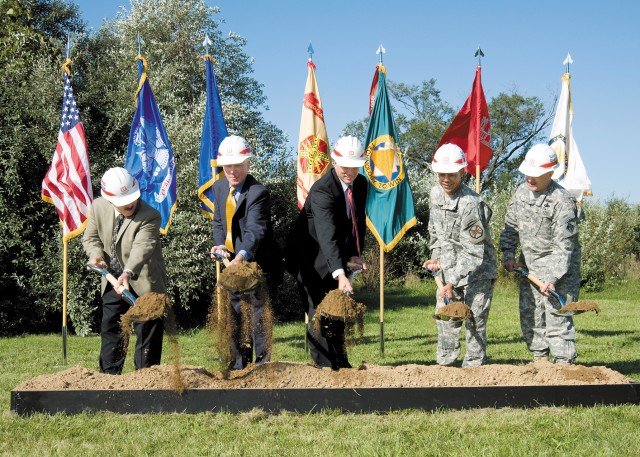
The U.S. Army Research Laboratory hosted a groundbreaking ceremony Sept. 3 for its Vehicle Technology Directorate's laboratory for specialized research, development, test and evaluation to be constructed at Aberdeen Proving Ground.
The U.S. Army Corps of Engineers, Baltimore District, initially awarded a $14.8 million contract in June to Walbridge-Aldinger Construction Company of Detroit to build the 35,930-square foot building that will house VTD's Mechanics and Propulsion divisions relocating from NASA sites in Virginia and Ohio. The move was scheduled in the 2005 Base Realignment and Closure legislation and is expected to consolidate and streamline VTD, which already has elements at APG.
Leadership from the APG Garrison, the U.S. Army Research, Development and Engineering Command, ARL, VTD and the USACE spoke at the ceremony.
With a mission of producing mobility-related science and technologies, the directorate already has excellent scientists and engineers, and the U.S. Army Corps of Engineers is providing the facilities needed to do their jobs, said Dr. Mark Nixon, VTD director.
The fully-functional laboratory, including specialized equipment, is expected to cost about $35 million when it's finished and will enable the directorate to conduct innovative in-house research in robotics, mechanics, propulsion and vehicle modeling as well as simulation, he added.
The VTD laboratory is just one part of the BRAC initiative at Aberdeen Proving Ground and the research and development capabilities will continue to improve, said Col. Andrew B. Nelson, APG BRAC Transformation Office.
"The ARL-VTD marks the nine hundred fifty million dollar mark of our one billion dollar BRAC program," Nelson said. "By summer of 2011, APG will have added more than three million square feet of operational and related space," he said.
Active and upcoming Corps projects at APG include the half billion dollar Phase I construction of the Command, Control, Communications, Computers, Intelligence, Surveillance and Reconnaissance, or Army Team C4ISR, headquarters and operations center (Phase II construction will begin this year as well); a headquarters center for the incoming U.S. Army Test and Evaluation Command; the Automotive Technology Evaluation Facility test tracks; the Non-Medical Chemical-Biological Facility; and the U.S. Army Medical Research Institute of Chemical Defense recapitalization project.
A groundbreaking ceremony is planned for the ATEC headquarters at APG Sept. 10 and for MRICD in the Edgewood Area Sept. 15.
"If you spend any time at APG, as most of you do, this is getting to be an almost weekly event," said Gary Martin, executive deputy to the commander, RDECOM.
Colonel Peter A. "Duke" DeLuca, USACE North Atlantic Division commander, related several personal experiences while leading forces in combat that reiterated the importance of the research conducted at ARL to Soldiers in the field.
High-altitude vehicle research to be conducted as a part of subsequent ARL-VTD construction will counter vehicle failure that troops under his leadership experienced while operating at elevations over 9,000 feet above sea level.
DeLuca also related having four vehicles blown out from under him in the field.
"In two of those cases I would either have been dead or seriously maimed if it were not for the frag kits developed by ARL," he said. "I say thank you to ARL, deeply and personally, on behalf of myself and my Soldiers."
DeLuca referred to Lt. Gen. William B. Caldwell IV, commander of the U.S. Army Combined Arms Center and Command and General Staff College, to describe the collaboration and cooperation efforts being undertaken at APG.
"C-3 for today's officer really means command, control and communication. The example of what 'right' looks like in that configuration is here at Aberdeen," DeLuca said.
"ARL research is protecting our Soldiers today and is developing technologies that will keep them lethal and safe in the future," said ARL Director John Miller. "This state-of-the-art facility will allow our VTD researchers to continue that vital work."
The building is expected to be completed by April 2011 and will include advanced capabilities to research aeromechanics and structures, mechanical systems and propulsion materials, among other areas.
About VTD
The U.S. Army Research Laboratory's Vehicle Technology Directorate is the principal Army organization responsible for the pursuit of mobility-related science and technologies. The directorate conducts innovative in-house research in robotics, mechanics, propulsion and vehicle modeling as well as simulation. It also coordinates technology applications within the Army, other services, industry and academia to leverage basic and applied research opportunities to benefit the Army. Its research leads to advanced capabilities and improved reliability for Army air and ground vehicles.
About ARL
The U.S. Army Research Laboratory, headquartered at Adelphi, Md., is the Army's corporate basic and applied research laboratory with the mission of providing innovative science, technology and analysis to enable full-spectrum operations. The Army relies on ARL for scientific discoveries, technologic advances, and analyses to provide Warfighters with capabilities to succeed on the battlefield. ARL consists of the Army Research Office and six directorates--Weapons and Materials, Sensors and Electron Devices, Human Research and Engineering, Computational and Information Sciences, Vehicle Technology and Survivability/Lethality Analysis.

Social Sharing